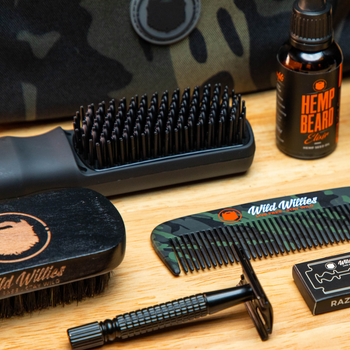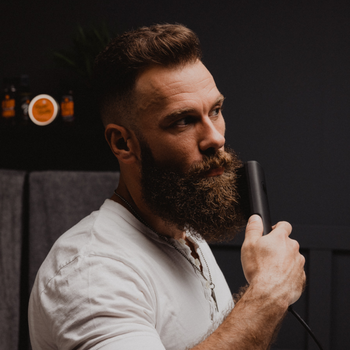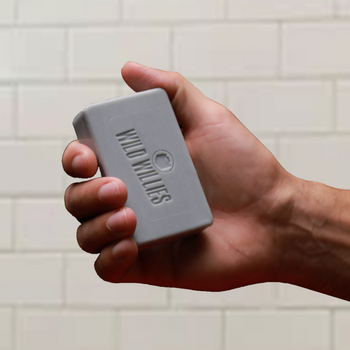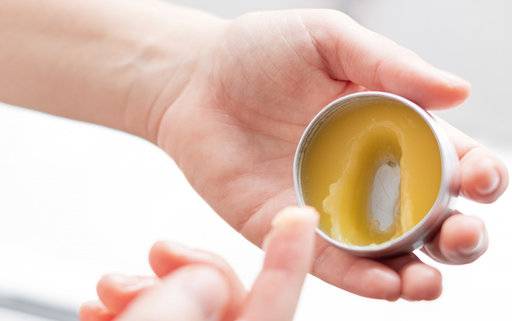Every young man looks forward to their first shave until they know better. Shaving can be quite a hassle and even painful if you don't know what you're doing. Many men take years to learn how to shave correctly with no issues. Unfortunately, many men continue to struggle with one issue in particular: razor burn.
Known as a type of irritant contact dermatitis or skin rash, the burn associated with razors or shaving is common and can occur anywhere you shave your skin, including:
- Face
- Armpits
- Chest
To reduce the occurrence of the irritation, you need to understand what causes the flare-up. Additionally, you should use the proper shaving techniques and products to relieve sensitive skin.
Table of Contents
Causes of Razor Burn
Razor burn has several common causes, including sensitive skin. However, while your natural tolerance for a razor or products can increase the likelihood of the skin rash, there are other potential causes that might be more likely.
Many men don't bother using shaving cream, gel, or other similar products. The purpose of creams and gels is to lubricate the skin, making it easier for the blade to glide across the skin and hair without pulling. Some men believe soap and water are sufficient for shaving, but they're not enough, despite providing some lubricating properties. Soap can damage your razor, potentially clogging the blades, increasing resistance and the possibility of irritation.
Irritation can also occur because you attempt to shave too quickly or repeatedly shave the same area trying for a smoother shave. With shaving and contact with the skin, less is more.
Finally, using an old razor or products that don't agree with your skin type can increase the possibility of skin irritation. You never want to hang onto a razor for more than a week or seven shaves. You also should pay close attention to ingredient labels to ensure the products are right for you.
How To Prevent Razor Burn
Shaving seems like a straightforward practice, and it does become one over time. However, without the proper tutelage, a young or grown man can develop poor practices, resulting in frequent razor burn. The fiery red skin is not a pleasant feeling; it is often itchy and burns. The problem is that irritation takes time to heal, usually longer than 24 hours, which means you will likely need a shave before your skin recovers, resulting in more irritation.
If you want to avoid skin irritation, you need to learn how to break the cycle, which means going back to the drawing board and allowing your skin to heal before shaving again — usually two to three days. While you wait for your skin to simmer down, learn about the shaving fundamentals that can reduce the risks of irritation.
1. Preparation
You can't just go at your face with a razor without warming it up first. Think about your face like a cute stranger you want to get to know. You wouldn't barge right up to that stranger and get cheek to cheek, would you? The meeting between your face and the razor is the same. Razor burn is more likely to occur if you rush things.
If you take your time and get a hot shower or wash your face in warm water, you allow your pores to open and your skin and facial hair to soften. Taking the time to prepare the face means your skin is more accepting of the razor; there will be less friction between the skin and the blade, reducing the likelihood of razor burn.
2. Razor Hygiene
Too many men hang on to their razors for far too long. An old, damaged, or clogged razor is the leading cause of the burn. When blades become dull, they require more force and pressure to perform an accurate or reliable shave. Professionals recommend that men replace their blades after seven shaves or once every three weeks, whichever comes first.
Additionally, you want to ensure you are rinsing your blades thoroughly in hot water, preferably under running water. If you only rinse your razor in a bowl of water, you might clog the blades with tiny hairs. Also, depending on the lubricant you use, a submerged rinse might not be enough to clear the gaps between the blades. When a razor is clogged, it pulls on the skin and hairs, and users may press harder to get a closer shave, further damaging the skin.
3. Badger Brush
Razor burn can also occur when you attempt to shave after growing out your facial hair for several days. The longer the hair is, the more likely a regular razor will pull at the hair and the skin. A badger brush is a tool for applying shave cream that works by lifting the hair away from the face. Using such a brush can make it easier for a razor to cut and glide over your face with minimal irritation.
As with all shaving accessories, prices vary on badger and beard brushes. Keep in mind that being expensive does not always indicate quality. Sometimes the higher price equates to greater brand recognition rather than materials or production. Always do your research when purchasing grooming products.
4. Grip and Grain Direction
When you shave, use a gentle hand. Using too much pressure is a surefire way to irritate the skin. Allow the tool to do the work. A razor is sharp and capable. All you need to do when shaving is gently guide the razor over your face.
There are some arguments about whether you should shave with or against the grain. Shaving against the grain tends to provide a closer shave, but it may increase the possibility of burn. The American Academy of Dermatology recommends shaving with the grain to prevent irritation, but that doesn't provide as close a shave. Ultimately, you'll need to experiment with the direction to find which method works for you.
5. Cleanser or Cold Water
After your shave, you want to close the pores and cool and soothe the face. The best way to cool the face is to rinse with cold water. Rinsing washes away any remaining debris and rapidly closes the pores. After rinsing your face, apply a post-shave cleanser followed by a moisturizer. Do not use an exfoliator after shaving; it will only aggravate the skin further. Use exfoliators at different times from when you shave. For instance, if you shave at night, exfoliate in the morning.
Difference Between Razor Burn and Razor Bumps
People often use the terms "razor burn" and "razor bumps" interchangeably, but each phrase represents a unique condition. Razor burns result from shaving; the blade against the skin causes friction and irritation, resulting in a minor skin rash. Razor bumps are effectively ingrown hairs.
Razor bumps can also occur because of shaving, but the result is not as immediate. Bumps occur as hair that was shaven, tweezed, or waxed regrows, but instead of growing out and away from the skin, the hair curls back into the skin. The bumps can become tender and inflamed and can potentially lead to a rash.
The condition is most prominent in Black men and people with curly hair. Most situations can resolve themselves, but in severe cases, razor bumps might require medical advice and treatment.
Razor Burn and Bump Treatment
When the best medicine for razor bumps and burns is avoidance, sometimes it is impossible. You can treat burns with aloe vera or avocado oil, which helps cool the skin. You can also apply a cool washcloth before using a moisturizer or another emollient. Don't use products with alcohol because they can make the irritation worse. You can further treat the inflammation with OTC options or home remedies, such as apple cider vinegar or tea tree oil with water.
You can treat razor bumps with a cortisone cream or prescription creams from your doctor. Do not shave the affected area for a minimum of three to four weeks or until the bumps heal. If you experience an infection or the bumps worsen, contact your doctor for an oral antibiotic.
Avoiding Other Common Shaving Pitfalls
Razor burn is not the only problem that comes from making common shaving mistakes. Men and women alike often experience nicks and cuts because they don't correctly prepare their bodies and hair for shaving. You cannot just dive in without preparing the skin and expect a flawless and close shave.
All too often, people are unaware of the mistakes they make when they shave. While there is an assumption that all men know how to shave, few have ever learned the proper technique. To prevent skin damage, you need to avoid six common shaving pitfalls.
1. Shaving First
Your skin needs time to warm up to the process of shaving. Too many men jump into a hot shower and immediately start whacking away at their faces. If you come at your face like a chore that needs to be accomplished as quickly as possible, you will irritate your skin and potentially injure yourself.
There is nothing wrong with shaving in the shower, but you don't want it to be the first thing you do. Instead, you should shave right before getting out of the shower. When your skin has time to warm up in the heat of the shower, it softens, and so does the hair, allowing for a gentler and more comfortable shave.
2. Dry Shaving
Some men have tougher skin than others, and they favor dry shaves. While some men might have durable skin that allows for such shaving techniques without issue, most men do not. Additionally, no dermatologist recommends dry shaving because it almost always results in skin irritation.
You should always use an appropriate shaving lubricant for your skin type. Everyone has different sensitivities or allergies, so you need to account for that when selecting your shaving cream or gel.
3. Multi-Directional Shaving
In an effort to accomplish the closest shave possible, some men choose a multi-directional shaving approach. They may start by shaving with the grain, then shift to shaving against it, and finally wrap things up by shaving side-to-side.
Multi-directional shaving is the definition of over-shaving. The more time you spend with a razor against your flesh, the more likely you will experience razor burn. You will significantly reduce your risk of burns if you pick a direction and stick to it. There is no need to go in every possible direction. Your shaving technique will eventually result in clean results.
4. Repeated Shaving
When shaving, go over one spot only once. There is no need to drag the razor across the same space over and over. Even following proper shaving techniques and going in the same direction, covering the same area repeatedly will increase the odds of skin irritation.
Trust the razor to do its job. Gently guide the blades over your lubricated face, putting light pressure on the tool. One pass with new blades should be enough to provide an accurate and well-manicured appearance.
5. Rapidfire Shaving
While you're a busy man, it's essential you take your time wielding the razor. Rapid-fire shaving is the gateway to injury at worst and irritation at best. The faster you pull the blades across your skin, the more likely you are to pull the hair and pull and pinch the skin, resulting in irritation and minor cuts or abrasions.
6. Moisturizer Avoidance
Too many men believe that moisturizer is for feminine people, but that is not true. Moisturizer is for everyone and is especially beneficial for those who shave often. These formulas help calm irritation and nourish the skin.
Limiting Razor Burn With the Right Products
Razor burn often stems from a lack of knowledge or experience with proper shaving techniques and tools. There is no shame in asking for help when you need it. Focusing on the correct shaving technique, including preparation and blade hygiene, can significantly reduce the likelihood of skin irritation during or after shaving. In addition, you always want to use the appropriate products. Visit the Wild Willies shop for great deals on a wide range of shaving items, and while you're there, consider the benefits of growing out your face mane.







